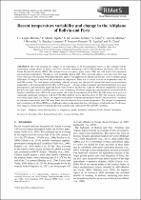Mostrar el registro sencillo del ítem
Recent temperature variability and change in the Altiplano of Bolivia and Peru
| dc.contributor.author | López-Moreno, J.I. | |
| dc.contributor.author | Morán-Tejeda, E. | |
| dc.contributor.author | Vicente-Serrano, S.M. | |
| dc.contributor.author | Bazo, Juan | |
| dc.contributor.author | Azorín-Molina, C. | |
| dc.contributor.author | Revuelto, J. | |
| dc.contributor.author | Sanchez‐Lorenzo, Arturo | |
| dc.contributor.author | Aguilar, E. | |
| dc.contributor.author | Chura, O. | |
| dc.coverage.spatial | Perú | |
| dc.coverage.spatial | Bolivia | |
| dc.coverage.spatial | Andes | |
| dc.coverage.spatial | Altiplano | |
| dc.date.accessioned | 2020-03-24T01:17:51Z | |
| dc.date.available | 2020-03-24T01:17:51Z | |
| dc.date.issued | 2015-08-26 | |
| dc.identifier.uri | https://hdl.handle.net/20.500.12542/299 | |
| dc.description.abstract | This work analysed the changes in air temperature in 25 meteorological stations in the Altiplano and the surrounding Andean slopes of Bolivia and Peru, and their relationship with El Niño-Southern Oscillation (SO) and the Pacific Decadal Oscillation (PDO). The analysis focused on annual, warm season (DJF) and cold season (JJA) maximum and minimum temperatures. All analyses were undertaken during 1965-2012, but some analyses were also from 1945 and 1955 when data were available. Principal component analysis was applied to the annual and seasonal series to identify spatial differences of changes in maximum and minimum air temperature. There was an overall increase of temperatures since the mid-20th century. The most intense and spatially coherent warming was observed for annual and warm season maximum temperature, with warming rates from 0.15 to 0.25 °C decade-1. Changes in the cold season maximum temperature were more heterogeneous, and statistically significant trends were mostly in the Bolivian Altiplano. Minimum temperatures increased, but there was higher spatial variability and lower rates of warming. Maximum temperature was negatively correlated with the Southern Oscillation index (SO) in the warm season, and positively correlated with the SO in the cold season; there were less statistically significant correlations with the PDO, that exhibited inverse sign than those for SO. The strongest correlations were in the region near Lake Titicaca. The negative correlation of minimum temperatures with SO and the positive correlation of minimum temperatures with PDO were lower than the observed for maximum temperature. The changes in temperature and correlations with SO and PDO were highly dependent on the selected period, with stronger trends in the last 30-40 years. This suggests reinforcement of warming rates that cannot be only explained by SO and PDO variability. | es_US |
| dc.format | application/pdf | es_PE |
| dc.language.iso | eng | es_PE |
| dc.publisher | John Wiley and Sons Ltd | es_PE |
| dc.relation.ispartof | urn:issn:1097-0088 | |
| dc.rights | info:eu-repo/semantics/openAccess | es_PE |
| dc.rights | Reconocimiento - No comercial - Sin obra derivada (CC BY-NC-ND) | es_PE |
| dc.rights.uri | https://creativecommons.org/licenses/by-nc-nd/4.0/ | es_PE |
| dc.source | Repositorio Institucional - SENAMHI | es_PE |
| dc.source | Servicio Nacional de Meteorología e Hidrología del Perú | es_PE |
| dc.subject | ENSO | en_US |
| dc.subject | Cambio Climático | en_US |
| dc.subject | Temperatura | en_US |
| dc.title | Recent temperature variability and change in the Altiplano of Bolivia and Peru | en_US |
| dc.type | info:eu-repo/semantics/article | es_PE |
| dc.identifier.isni | 0000 0001 0746 0446 | |
| dc.description.peerreview | Por pares | es_PE |
| dc.identifier.doi | https://doi.org/10.1002/joc.4459 | |
| dc.identifier.journal | International Journal of Climatology | es_PE |
| dc.subject.ocde | https://purl.org/pe-repo/ocde/ford#1.05.10 | es_PE |
| dc.subject.sinia | temperatura - Clima y Eventos Naturales | es_PE |
| dc.type.sinia | text/publicacion cientifica | es_PE |
| dc.identifier.url | https://hdl.handle.net/20.500.12542/299 | |
| dc.identifier.url | https://hdl.handle.net/20.500.12542/299 |
Ficheros en el ítem
Este ítem aparece en la(s) siguiente(s) colección(es)
-
Artículo científico [176]









